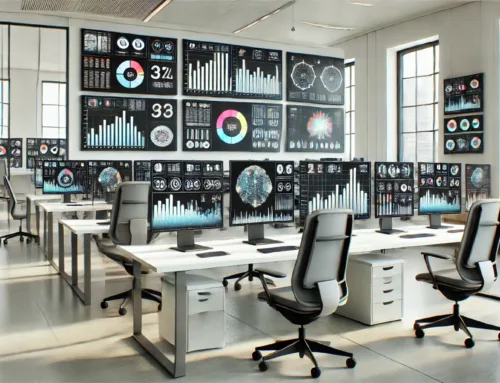To enhance data visualization in your agency, ensuring the accuracy and quality of your data is paramount. But what happens once you have reliable data in hand? That’s where the real magic begins. By implementing strategic adjustments to your data visualization processes, you can truly transform your agency’s ability to extract insights and make informed decisions. So, let’s explore how you can take your data visualization practices to the next level and unlock the full potential of your agency’s data-driven initiatives.
Review Current Practices
When evaluating the effectiveness of data visualization in your agency, the first step is to review current practices. Start by assessing the data accuracy in your visualizations. Ensure that the information presented is reliable, up-to-date, and without errors. Look into the processes involved in gathering and analyzing data to guarantee its accuracy before visualization.
Next, evaluate the visualization tools being utilized. Consider if the tools are appropriate for the type of data being visualized and if they effectively communicate the insights derived. Assess if there are any new or more advanced visualization tools available that could enhance the presentation of data in your agency.
Identify Areas for Improvement
To enhance your agency’s data visualization practices, the next step involves identifying specific areas that can be improved upon. Begin by evaluating the processes currently in place for creating and presenting data visualizations. Look at how data is collected, analyzed, and transformed into visual representations. Consider if there are any bottlenecks, inefficiencies, or gaps in the current workflow that may be hindering the effectiveness of your data visualizations.
Once you have identified areas for improvement, it’s time to implement changes. This could involve streamlining data collection methods, enhancing data analysis techniques, or adopting new tools and technologies to create more impactful visualizations. Consider training staff on best practices in data visualization or investing in software that enables more interactive and dynamic visualizations.
Seek Employee Input
Encouraging employee engagement is key to fostering a collaborative decision-making process within your agency. By seeking input from your team members, you not only gain valuable insights but also create a culture of inclusivity and innovation. Empowering your employees to share their perspectives can lead to more comprehensive and effective data visualization strategies.
Employee Engagement Strategies
Fostering a culture of collaboration and inclusivity within your agency is essential for creating effective employee engagement strategies. Encouraging team brainstorming sessions can be a powerful way to involve employees in decision-making processes and gather diverse perspectives. By allowing your team members to contribute their ideas and insights, you not only make them feel valued but also tap into a wealth of creativity and knowledge.
Another engaging approach is to incorporate gamification techniques into your employee engagement strategies. Gamification can make tasks more fun and interactive, motivating employees to participate actively. Consider introducing challenges, rewards, or friendly competitions to keep your team members engaged and excited about their work.
Collaborative Decision-Making Process
During the decision-making process within your agency, seeking employee input is crucial for fostering a culture of collaboration and inclusivity. Team brainstorming sessions can be incredibly valuable in harnessing the collective intelligence of your staff. Encouraging open dialogue and active participation in decision-making not only empowers employees but also leads to better outcomes. By involving your team in interactive workshops, you can tap into a diverse range of perspectives and ideas that may not have been considered otherwise.
When employees feel heard and valued, they are more likely to be invested in the decisions that are made. This sense of ownership can significantly boost morale and productivity within your agency. Furthermore, collaborative decision-making fosters a sense of unity and shared purpose among team members. By creating opportunities for everyone to contribute their thoughts and insights, you are not only improving the quality of your decisions but also building a stronger, more cohesive team.
Provide Additional Training
To enhance the effectiveness of data visualization within your agency, consider the value of providing additional training opportunities for your team. Offering specialized workshops can equip your employees with valuable skills and insights into the latest trends and techniques in data visualization. Hands-on practice during these workshops allows team members to apply theoretical knowledge to real-world scenarios, enhancing their proficiency in creating impactful visual representations of data.
Bringing in external experts to conduct training sessions can provide a fresh perspective and introduce advanced techniques that your team may not have encountered before. These experts can offer guidance on optimizing visualization tools, interpreting complex data sets, and designing visually appealing dashboards. By investing in training programs led by industry professionals, your agency can stay ahead of the curve and ensure that your team is equipped with the knowledge and skills needed to produce high-quality and insightful data visualizations.
Update Tools and Software
Consider the impact of updating tools and software on your agency’s data visualization capabilities. Technology upgrades can significantly enhance the way your team processes and presents data. By investing in the latest software integration, you can streamline your data visualization process, making it more efficient and impactful. Upgrading tools can provide access to advanced features that enable you to create more interactive and engaging visualizations, ultimately improving the communication of insights to stakeholders.
Software integration plays a crucial role in ensuring that different tools work seamlessly together, eliminating compatibility issues and saving time. By updating your tools and software, you can stay ahead of the curve in data visualization trends and techniques. This proactive approach can help your agency adapt to changing data requirements and deliver more compelling visualizations. Embracing technology upgrades demonstrates a commitment to innovation and continuous improvement in your data visualization efforts.
Revise Data Collection Methods
Your agency’s data visualization efforts heavily rely on the quality and accuracy of the data collected. To enhance data quality and process efficiency, it is crucial to revise your data collection methods. Start by ensuring that the data you collect is relevant to your visualization goals. Define clear objectives for data collection to avoid gathering unnecessary information that could dilute the quality of your visualizations.
Next, streamline your data collection processes to improve efficiency. Implement automated data collection tools where possible to reduce manual errors and save time. Regularly review and update your data collection methods to adapt to changing business needs and technological advancements.
Moreover, consider implementing data validation techniques to verify the accuracy and completeness of the data collected. This will help maintain data integrity and reliability in your visualizations.
Frequently Asked Questions
How Can We Ensure Data Privacy and Security in Visualizations?
To ensure data privacy and security in visualizations, prioritize privacy protection through encryption. Implement robust security measures to meet compliance requirements. Safeguard sensitive information by encrypting data and adhering to regulatory standards for secure data visualization practices.
What Strategies Can We Use to Make Complex Data More Understandable?
To make complex data more understandable, simplify concepts and engage in user testing. Break down information into digestible parts and gather feedback from users to refine visuals. This iterative process ensures clarity and effectiveness in conveying data insights.
How Can We Encourage Employees to Embrace Data Visualization?
To encourage employees to embrace data visualization, engage them through interactive training programs. Boost data literacy with incentives that recognize and reward their efforts. By investing in their skills and motivation, you cultivate a culture of data-driven decision-making.
Are There Any Industry-Specific Data Visualization Techniques to Consider?
Considering industry-specific data visualization, healthcare insights benefit from visualizing patient outcomes, while retail trends thrive on sales data visualization. Tailor your techniques to these specific needs for impactful visual representations that drive informed decision-making in your agency.
How Often Should We Reassess Our Data Visualization Methods for Effectiveness?
Regularly reassess your data visualization methods for effectiveness. Update frequency based on user feedback and performance monitoring results. Incorporate industry-specific techniques and adjust as needed. This ongoing evaluation ensures your visualizations remain impactful and informative.




